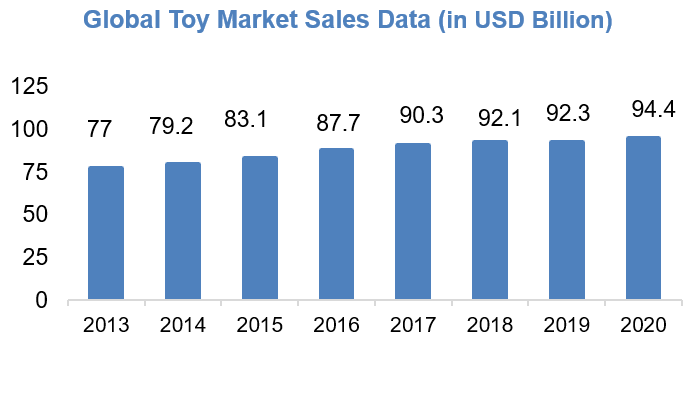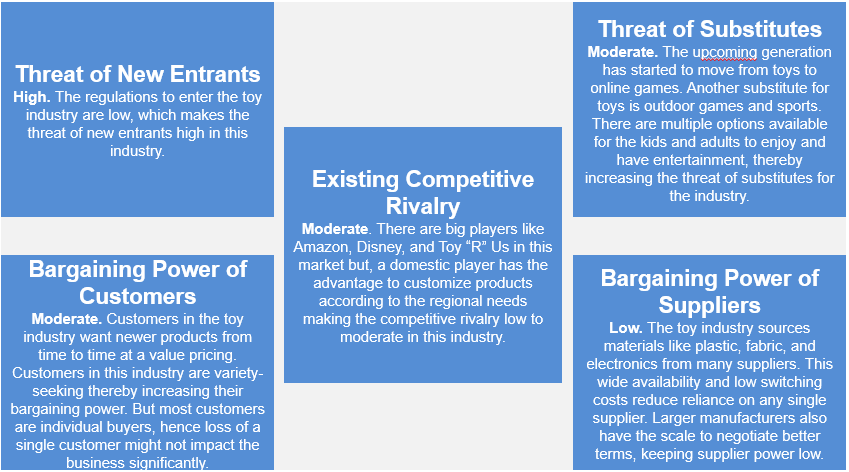Global Toy Industry
The toy industry comprises companies involved in designing, manufacturing, and selling toys globally. The sector caters to children’s developmental, educational, and entertainment needs through a variety of physical and digital products.

Global Market Size
The global toys market was valued at over USD 120 billion in 2023 2, growing at a CAGR of approximately 4% between 2017 and 2023 2. Leading players in this sector include Walt Disney Co., Mattel, Hasbro, Playmates Toys, and Games Workshop Group

Regional Insights
- Europe is the third-largest market after North America and Asia. 4
- In 2020, offline channels led toy sales globally, accounting for 51.57% of total distribution. 5
- However, online channels are rapidly gaining ground, with over 25% of toys in Europe sold online. 4

Market Size and Consumer Spending – Europe
- In the European Union, the average toy expenditure per child was USD 212. 4
- The EU toy market size was valued at USD 24.6 billion, projected to grow at a CAGR of 15.59% from 2022 to 2025, reaching USD 96.5 billion. 4
Industry Structure
- 99% of toy manufacturers in the EU are SMEs, with most employing fewer than 10 people. 3
- These SMEs collectively employ around 51,000 workers, generating a production value of EUR 5.8 billion. 3

Porter’s Five Forces for the Global Toys Industry

Threat of New Entrants - High
The regulations to enter the toy industry are low, which makes the threat of new entrants high in this industry.
Threat of Substitutes - Moderate
The upcoming generation has started to move from toys to online games. Another substitute for toys is outdoor games and sports. There are multiple options available for kids and adults to enjoy and have entertainment, thereby increasing the threat of substitutes for the industry.
Bargaining Power of Customers - Moderate
Customers in the toy industry want newer products from time to time at value pricing. Customers in this industry are variety-seeking, thereby increasing their bargaining power. But most customers are individual buyers, hence the loss of a single customer might not impact the business significantly.
Existing Competitive Rivalry - Moderate
There are big players like Amazon, Disney, and Toy “R” Us in this market, but a domestic player has the advantage to customize products according to regional needs, making the competitive rivalry low to moderate in this industry.
Bargaining Power of Suppliers - Low
The toy industry typically sources raw materials such as plastic, fabric, and electronic components from a wide range of suppliers. The availability of multiple suppliers and relatively low switching costs reduce the dependency on any single supplier. Additionally, many toy manufacturers have the scale and negotiating power to demand favorable terms, which keeps the overall bargaining power of suppliers low.
- https://www.statista.com/forecasts/1435227/revenue-toys-games-toys-hobby-market-worldwide
- https://www.researchandmarkets.com/reports/5135123/toys-market-global-outlook-and-forecast-2020-2025
- https://single-market-economy.ec.europa.eu/sectors/toys_en
- https://www.eurodev.com/blog/5-toy-industry-trends-in-europe
- https://www.grandviewresearch.com/industry-analysis/toys-games-market
- https://worthly.com/business/five-largest-toy-companies-world/